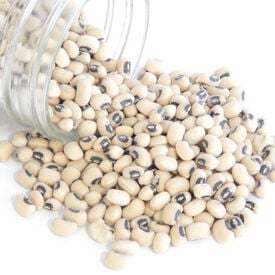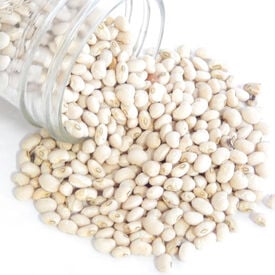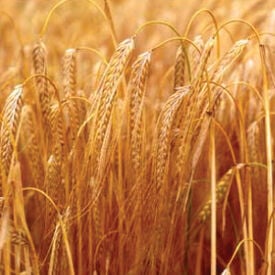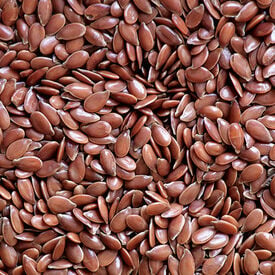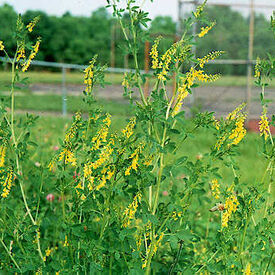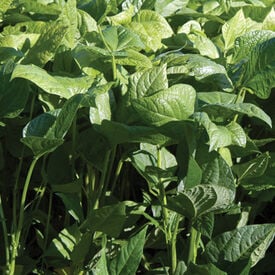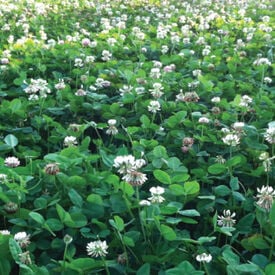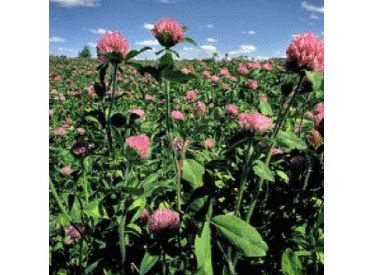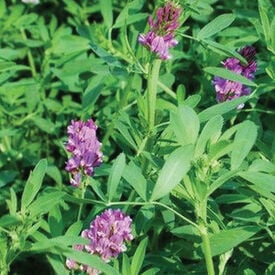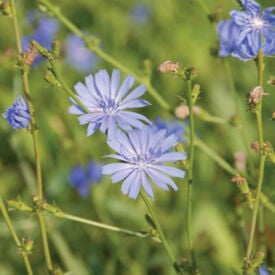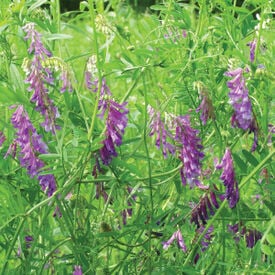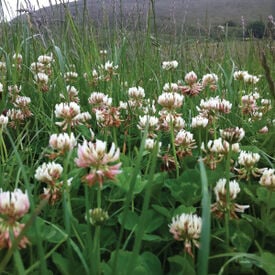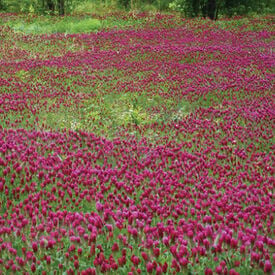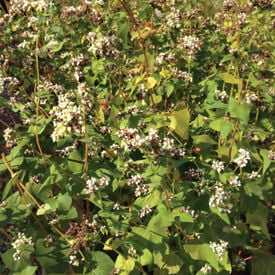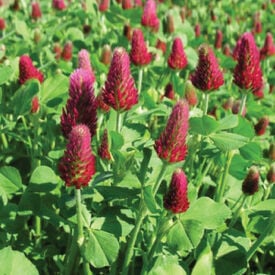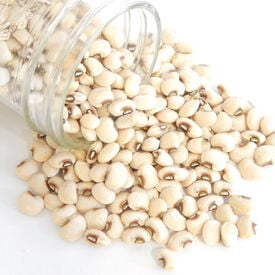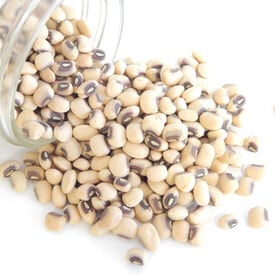California Blackeye #5 is a high yielding, vigorous and easy to grow. You can use these as green shell peas or dry like winter beans. Pods reach 6-8" long and are loaded with creamy, delicious seeds. Does well in high heat areas. Treated Seed.
The Texas Cream is a heavy yielding Southern cowpea that is great for fresh shelling. This variety is very similarly to 'Sadandy' but the cowpeas are slightly larger. These bush-type plants are prolific and thrive in hotter, Southern weather. Texas Cream is a "cream pea" type variety, they are generally used at the fresh shelling stage. Treated Seed.
The Thoroughbred Barley is a widely adapted variety of barley that is high yielding, with a great straw strength and a high test weight. This grain is a good standing six-rowed barley. This variety is resistant to powdery mildew and barley yellow dwarf virus. Uses: Bees & Beneficial Insects, Erosion Control, Green Manure, Nitrogen Scavenger, No Till, Organic Matter (Biomass), Weed Suppression
The Common Flax is a cool season annual broadleaf with small taproots and very small, narrow leaves that are less than an inch long. This variety's stems are branched near the base of the plant, with plants reaching 30 to 36 inches in height. The multiple stems or branches of a flax plant are slender and flexible, bearing attractive blue flowers. Flax has the same performance benefits of other grasses and grains, of quick germination and a highly fibrous root mass. Flax will take up excess N and other minerals, will winter kill and provide moderate to high amounts of organic matter back to the soil. Flax provides excellent mulch for protection of erosion and improving water permeation during the winter and spring. Flax (Linum usitatissimum): Cool season, broadleaf, Annual, Upright plant habit Uses: Bees & Beneficial Insects, Chicken Forage, Erosion Control, Green Manure, Nitrogen Savenger, No Till, Organic Matter (Biomass)
The Sweet Clover is a legume that is exceptional for not only attracting honey bees to the garden, but also creating green manure! This clover can grow nearly anywhere under most conditions. The Sweet Clover is our favorite clover because it is more versatile than other clovers at nitrogen fixating, erosion control and attracting beneficial insects. This variety is slow to establish the first year but comes on fast the following year and can produce up to 170 lb. of nitrogen per acre. The Sweet Clover comes OMRI Pre-inoculated. Uses: Bees & Beneficial Insects, Chicken Forage, Compaction Control, Deer Attractant, Erosion Control, Forage, Green Manure, Nitrogen Fixation, No Till, Weed Suppression
Iron and Clay cowpeas makes a great cover crop for smothering weeds and adding Nitrogen to soil. This variety of cowpeas are grown just like soybeans. Iron and Clay is a fast growing plant that can reach 3'. The best time to plant is during spring for best results as the frost will kill the cowpeas. Iron and Clay has long taproots that help withstand drought conditions and can produce as much as 300 lb./acre nitrogen. This variety has a high organic matter production. Broadcast up to 120 lb./acre, 1/2 to 1" deep. Try with cowpea inoculant for maximum Nitrogen fixation.
The Ladino Clover is the most popular white clover in the USA as it is two to four times as large as the common white clover! This clover has a high nutritive value and is palatability, making it a popular choice in pasture mixtures. It is not deep rooted, and will not tolerate much drought. Ryegrass and orchardgrass work well with ladino clover in mixtures. Broadcast at 25 lbs. per acre. Seed comes inoculated. Uses: Bees & Beneficial Insects, Chicken Forage, Compaction Control, Deer Attractant, Erosion Control, Forage, Green Manure, Nitrogen Fixation, No Till, Weed Suppression
The Mammoth Red Clover is a large, fast growing clover that is an ideal grazing crop and can be sowed in spring, summer or fall! Mammoth Red is a popular biennial clover used for Nitrogen addition and hay crops. This red clover may be the best choice for frost seeding; it is extremely cold hardy and does well in most soils and growing conditions. The Mammoth Red Clover will fix up to 70-110 lbs. nitrogen per acre. This variety's long tap roots loosen soils and mine phosphorus and other nutrients from deep in the soil. Uses: Bees & Beneficial Insects, Chicken Forage, Compaction Control, Deer Attractant, Erosion Control, Forage, Green Manure, Nitrogen Fixation, No Till, Weed Suppression
The Common Alfalfa is a somewhat winter hardy perennial legume, but it grows more quickly than other regular alfalfa varieties. As an annual green manure, this cool-season "Summer" alfalfa can produce up to 10 tons of organic matter per acre. Its long taproots break up compacted soil and bring up subsurface minerals. High nitrogen fixation and great bee forage. Alfalfa is basically good at everything, as it great for nitrogen fixation and bee forage! Just look at all it's uses below! Alfalfa (Medicago sativa L.): Cool season, broadleaf, Perennial, Legume (N-fixation), Upright plant growth, Crude protein: hay or silage 14-22% Uses: Bees & Beneficial Insects, Chicken Forage, Compaction Control, Deer Attractant, Erosion Control, Forage, Green Manure, Nitrogen Fixation, Nitrogen Scavenger, No Till, Organic Matter (Biomass), Weed Suppression
Chicory has a long taproot that penetrates subsoils which makes it drought tolerant and allows it to make minerals more available to livestock. Rich in potassium, sulfur, calcium, zinc, sodium, manganese and iron. When managed properly, Chicory produces leafy growth which is higher in nutritive and mineral content than alfalfa and other cool season grasses. Used mainly in mixes with other pasture or cover crop seeds. Chicory (Cichorium intybus L.) - Warm season, broadleaf - Perennial - Upright and spreading growth habit - Protein levels: 10-32% - Forms arbuscular mycorrhizal associations Uses: - Bees & Beneficial Insects - Chicken Forage - Deer Attractant - Forage
When sown late summer, the Hairy Vetch spring regrowth is vigorous and nitrogen-producing, for tilling in before planting spring garden crops. You can sow with or without grain, grass or field peas! The typical nitrogen produced of this legume is 100 lbs. per acre. The Hairy Vetch has rapid growth that makes it a good weed suppressant. Uses: Bees & Beneficial Insects, Chicken Forage, Deer Attractant, Erosion Control, Forage, Green Manure, Nitrogen Fixation, No Till, Weed Suppression
The White Dutch Clover is a perennial clover variety that is a customer favorite for controlling erosion while protecting the soil! This legume is a living mulch of permanent cover that spreads by stolons. Grow low so takes close mowing and grazing. The White Dutch Clover benefits bees and insects as well as fixes nitrogen. Uses: Bees & Beneficial Insects, Chicken Forage, Deer Attractant, Erosion Control, Forage, Green Manure, Nitrogen Fixation, No Till, Weed Suppression
The Medium Red Clover is fast to establish and can be grown in most soil types as well as sowed in spring, summer or fall! This clover works well for hay or silage. The Medium Red Clover can be used as a cover crop between rows of vegetable crops if mowed to maintain manageability. This clover can fix up to 150 lb. of nitrogen per acre. Uses: Bees & Beneficial Insects, Chicken Forage, Compaction Control, Deer Attractant, Erosion Control, Forage, Green Manure, Nitrogen Fixation, No Till, Weed Suppression
The Common Buckwheat is a grain that can be planted late spring to early summer and improves top soil and an effective choke weed! This variety establishes quickly and matures in 60 days. This buckwheat accumulates phosphorus and and potassium for following crops and is frost sensitive. Buckwheat (Fagopyrum esculentum Moench): Cool Season, Grain, Annual, Upright growth habit, Enhances soil P availability,Crude protein: straw 5%, grain 13% Uses: Bees & Beneficial Insects, Green Manure, No Till, Organic Matter (Biomass), Weed Suppresion
Phenomenal cowpeas are a remarkable variety known for their impressive yield and versatility. These cowpeas produce robust, productive plants that are well-suited to a variety of growing conditions, making them a favorite among gardeners and farmers. Characterized by their large, green pods and high nutritional value, Phenomenal cowpeas offer a rich source of protein, fiber, and essential vitamins. The plants typically reach about 2 to 3 feet in height and can be grown both in garden beds and containers. They are valued for their resilience in hot and dry climates, which makes them particularly well-adapted to regions with challenging weather conditions. With a maturity period of around 70 to 80 days, Phenomenal cowpeas provide a generous harvest of flavorful, tender beans that can be enjoyed fresh, dried, or cooked in a variety of dishes. Their adaptability and high productivity make them a standout choice for both home gardeners and commercial growers.
The Crimson Clover is an attractive winter annual that can be planted fall or early spring and will protect and improve the soil. This good nitrogen fixer (70-150 lbs per acre per year) blooms showy crimson flowers in late spring that are an excellent source of nectar for bees. This variety inter-seeds well with grass, making it a great way to ready your vegetable garden for the spring or beautify a landscape! Not to be confused with the tough perennial clovers that can take over a meadow. Uses: Bees & Beneficial Insects, Chicken Forage, Compaction Control, Deer Attractant, Erosion Control, Forage, Green Manure, Nitrogen Fixation, No Till, Weed Suppression
The Big Boy Purplehull is a high yielding, popular Southern cowpea that is great for home gardens. Big Boy Purplehull is a long podded variety with 13-16 peas per pod that are light tan in color and oblong shape. This is a good garden variety and is very prolific. If you are using for Nitrogen fixation we highly recommend using a cowpea inoculant. Try with cowpea inoculant for maximum Nitrogen fixation.
The Quickpick Pinkeye cowpea is a bush type southern cowpea with early maturity and good disease resistance. This variety is a pinkeye Purplehull type variety that is determinate, erect, compact (reach about 20 inches), and non-vining. This cowpea gets its name, Quickpick, because it matures in about 60 days. The pods are dark-purple and about seven to eight inches long containing nine to eleven, kidney-shaped seeds with large, maroon colored eyes. If you are using for Nitrogen fixation we highly recommend using a cowpea inoculant. Try with cowpea inoculant for maximum Nitrogen fixation.
